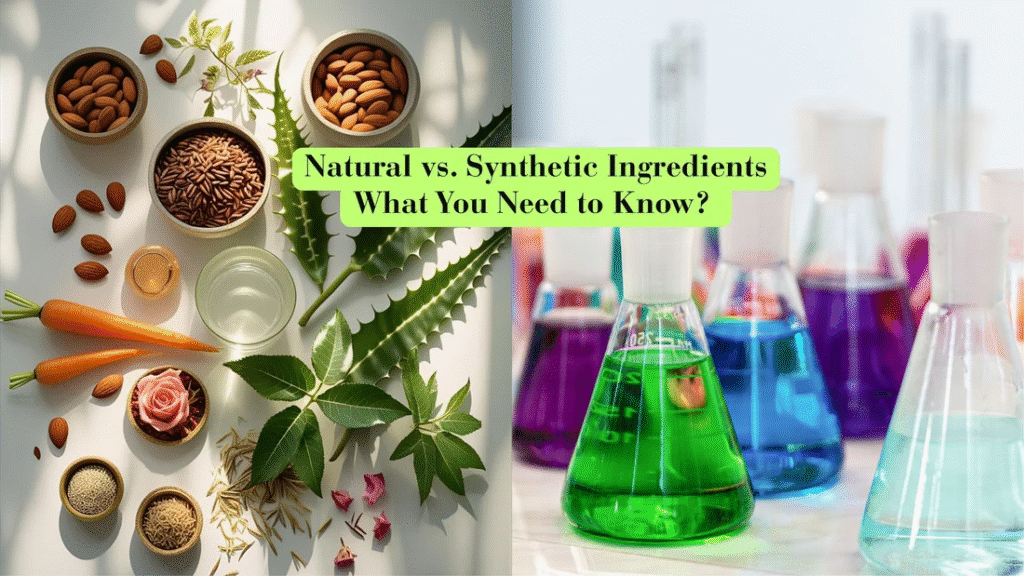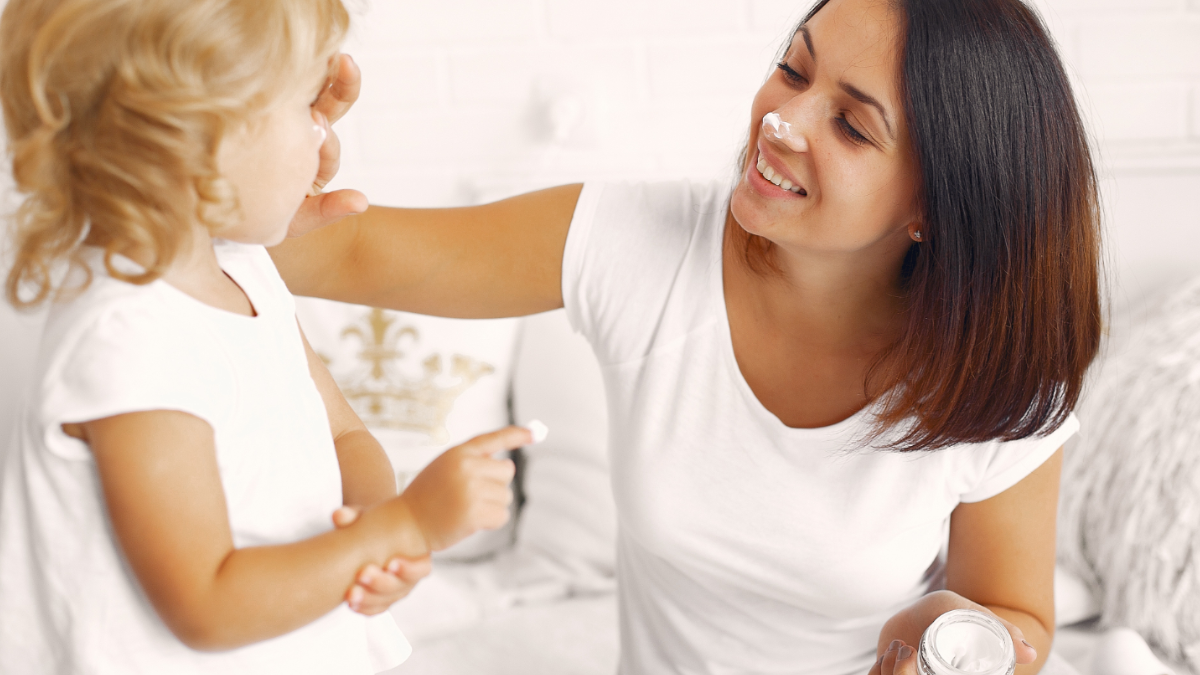Children’s skin is soft, delicate, and more sensitive than adults’. It deserves special care, free from harsh chemicals and synthetic ingredients. Whether it’s dryness, rashes, or sun exposure, a child’s skin needs gentle protection every day.
Unfortunately, many parents believe skincare is only for adults. In reality, establishing a natural and safe skincare routine for kids helps maintain healthy, glowing, and irritation-free skin — and teaches good hygiene habits early on.
This guide will help parents understand how to care for their little one’s skin the right way — with simple, natural, and safe methods backed by dermatologists.
1. Understanding Children’s Skin

Kids’ skin is 30% thinner than adult skin, making it more vulnerable to dryness, sunburn, and environmental damage. Their skin barrier (the layer that locks in moisture and protects against irritants) is still developing, so it requires gentle and balanced care.
Common Skin Issues in Kids:
- Dryness or flakiness due to weather changes
- Rashes from heat, friction, or allergies
- Eczema and irritation caused by harsh soaps or fabrics
- Sun sensitivity due to thin skin layers
Knowing your child’s skin type and needs helps you choose the right products and routines.
2. The Golden Rule — Keep It Simple
Children do not need a long list of skincare products. A simple 3-step routine is best:
Cleanse → Moisturize → Protect.
Why simplicity works:
- Fewer products mean fewer chances of irritation.
- Natural ingredients support skin health without overloading it.
- It builds a consistent, easy routine for kids to follow.
3. Step One: Cleansing the Right Way
Cleansing is essential, but harsh soaps can strip a child’s skin of its natural oils.
Tips for Gentle Cleansing:
- Use a mild, fragrance-free cleanser or baby wash.
- Avoid antibacterial soaps unless prescribed by a doctor.
- Bathe your child with lukewarm water, not hot water.
- Limit bath time to 10–15 minutes.
Natural Ingredients to Look For:
- Aloe vera: Soothes and hydrates
- Oatmeal: Reduces itching and inflammation
- Coconut-based cleansers: Mild and moisturizing
Gentle cleansing keeps skin fresh, clean, and balanced without dryness.
4. Step Two: Moisturizing for Soft, Supple Ski
Children’s skin loses moisture quickly, especially after bathing or during winter. A moisturizer helps restore hydration and strengthens the skin barrier.
Best Practices:
- Apply moisturizer right after bathing to lock in moisture.
- Choose fragrance-free, hypoallergenic creams or lotions.
- For very dry skin, use thicker creams or natural oils (like coconut or almond oil).
Ingredients to Avoid:
- Artificial fragrances
- Alcohol-based lotions
- Petroleum-heavy products
Natural moisturizers keep the skin soft and prevent dryness, rashes, and irritation.
5. Step Three: Sun Protection — Start Early
Many parents forget sunscreen for kids, but UV rays can damage young skin quickly. Children over six months should use safe sun protection daily.
Safe Sunscreen Tips:
- Use mineral-based sunscreens with zinc oxide or titanium dioxide.
- Choose SPF 30 or higher for outdoor play.
- Apply 15–20 minutes before going outside and reapply every 2 hours.
- For babies under 6 months, use shaded protection and clothing instead of sunscreen.
Bonus Tip:
Always test new sunscreen on a small patch of skin to check for reactions.
6. Choosing Natural and Safe Ingredients

The safest skincare for kids comes from nature. Look for products that are free from parabens, sulfates, artificial colors, and strong fragrances.
Gentle, Kid-Friendly Ingredients:
- Shea Butter: Deeply nourishes and softens skin.
- Coconut Oil: Natural moisturizer with antibacterial benefits.
- Chamomile: Calms redness and irritation.
- Aloe Vera: Soothes burns, rashes, and dryness.
- Oat Extract: Restores moisture and soothes sensitive skin.
These ingredients are gentle enough for daily use and support healthy skin development.
7. Common Skincare Mistakes Parents Should Avoid
Even with good intentions, parents sometimes make skincare errors that can cause irritation.
Avoid These Mistakes:
- Using adult products on kids’ skin.
- Overbathing — this strips away protective oils.
- Applying talc-based powders (can cause dryness and breathing issues).
- Using scented wipes or soaps too frequently.
- Ignoring sun protection during outdoor activities.
Always choose mild, dermatologist-tested, and age-appropriate products.
8. Skincare for Different Ages
Children’s skincare needs evolve as they grow.
Infants (0–1 year):
- Bathe every 2–3 days unless dirty.
- Use mild baby wash and gentle oil massages.
Toddlers (1–5 years):
- Cleanse daily after playtime.
- Moisturize after bath; apply sunscreen before outdoor play.
Older Kids (6–12 years):
- Teach basic self-care: washing face, moisturizing, using sunscreen.
- Encourage healthy habits like hydration and cleanliness.
Early education builds a lifetime of good skin habits.
9. Lifestyle Habits That Keep Kids’ Skin Healthy
Healthy skin starts with a healthy lifestyle.
Tips for Parents:
- Ensure your child drinks enough water.
- Provide a balanced diet rich in fruits, vegetables, and omega-3 fats.
- Dress them in cotton clothes to let the skin breathe.
- Maintain short, clean nails to prevent scratching infections.
- Keep bath towels and sheets clean and soft.
Simple habits create a strong foundation for lifelong skin health.
10. When to See a Dermatologist
Sometimes, a rash or irritation may require medical attention.
Consult a Doctor If:
- The rash doesn’t heal within a few days.
- There’s excessive itching, bleeding, or pus.
- The child has eczema or allergic reactions.
- You’re unsure about which products are safe to use.
Professional guidance ensures the best care for sensitive skin conditions.
Also Read:Healthy Skin Starts Here: Simple Routines for Lasting Radiance
Conclusion
Your child’s skin deserves gentle love and protection. With safe, natural skincare habits, you can keep their little faces glowing, healthy, and happy every day.
Remember, less is more — avoid harsh chemicals, keep routines simple, and focus on hydration and sun protection.
By teaching kids early about self-care, you’re not just protecting their skin — you’re helping them grow into confident, healthy adults who respect their body’s needs.
Gentle care today builds stronger, healthier skin for tomorrow
FAQs
Q1. Can kids use adult skincare products?
No. Adult products are too strong for children’s delicate skin and can cause irritation or allergies.
Q2. How often should I moisturize my child’s skin?
Once or twice daily, especially after baths or during dry weather.
Q3. Is sunscreen safe for babies?
For babies under 6 months, avoid sunscreen; instead, use shade and protective clothing.
Q4. What are the best natural oils for kids’ skin?
Coconut oil, almond oil, and shea butter are great natural moisturizers.
Q5. How can I treat mild rashes at home?
Keep the area clean and dry, apply aloe vera or a gentle moisturizer, and avoid scratching.

